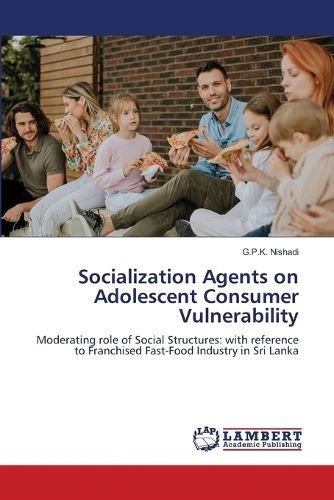Readings Newsletter
Become a Readings Member to make your shopping experience even easier.
Sign in or sign up for free!
You’re not far away from qualifying for FREE standard shipping within Australia
You’ve qualified for FREE standard shipping within Australia
The cart is loading…






This title is printed to order. This book may have been self-published. If so, we cannot guarantee the quality of the content. In the main most books will have gone through the editing process however some may not. We therefore suggest that you be aware of this before ordering this book. If in doubt check either the author or publisher’s details as we are unable to accept any returns unless they are faulty. Please contact us if you have any questions.
Adolescents are considered a highly vulnerable customer group owing to their overconsumption of fast food, and existing scholars suggest that socialization agents play a prominent role in adolescent nutritional knowledge and purchasing preferences. Additionally, the current literature highlights that the consumption of fast food varies with social structures. Within this backdrop, the study aimed to analyze the moderating role of social structures on socialization agents and adolescent consumer vulnerability, due to the scarcity of existing studies relevant to the field. Primary data were collected from 910 adolescents studying in national government schools in Sri Lanka based on a stratified random sampling method. Results indicated that the five socialization agents; Peers, Parents, TV advertisements, the Internet, and Retailers-have a positive influence on adolescent consumer vulnerability in the Sri Lankan franchised fast-food industry, proving the first five hypotheses. Further, hypothesis six, seven, eight and nine were also proved, revealing that Family Income, Mother's Employment, Area Structure and Family Structure significantly moderates the above direct relationship.
$9.00 standard shipping within Australia
FREE standard shipping within Australia for orders over $100.00
Express & International shipping calculated at checkout
This title is printed to order. This book may have been self-published. If so, we cannot guarantee the quality of the content. In the main most books will have gone through the editing process however some may not. We therefore suggest that you be aware of this before ordering this book. If in doubt check either the author or publisher’s details as we are unable to accept any returns unless they are faulty. Please contact us if you have any questions.
Adolescents are considered a highly vulnerable customer group owing to their overconsumption of fast food, and existing scholars suggest that socialization agents play a prominent role in adolescent nutritional knowledge and purchasing preferences. Additionally, the current literature highlights that the consumption of fast food varies with social structures. Within this backdrop, the study aimed to analyze the moderating role of social structures on socialization agents and adolescent consumer vulnerability, due to the scarcity of existing studies relevant to the field. Primary data were collected from 910 adolescents studying in national government schools in Sri Lanka based on a stratified random sampling method. Results indicated that the five socialization agents; Peers, Parents, TV advertisements, the Internet, and Retailers-have a positive influence on adolescent consumer vulnerability in the Sri Lankan franchised fast-food industry, proving the first five hypotheses. Further, hypothesis six, seven, eight and nine were also proved, revealing that Family Income, Mother's Employment, Area Structure and Family Structure significantly moderates the above direct relationship.